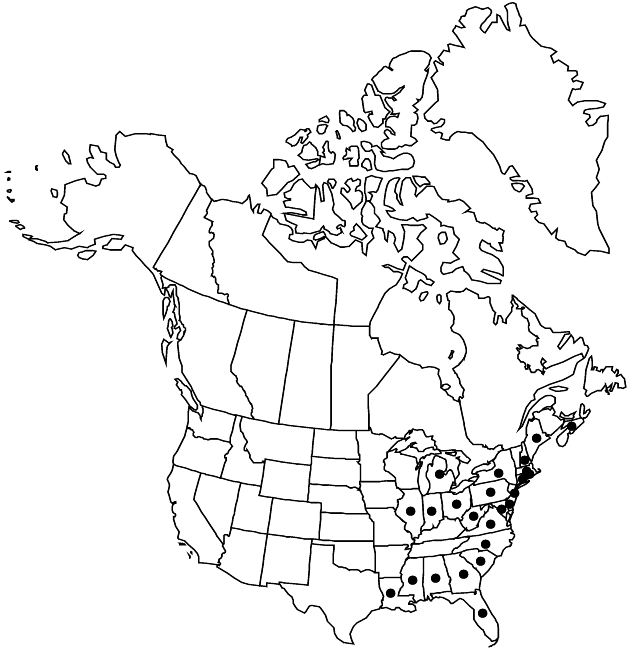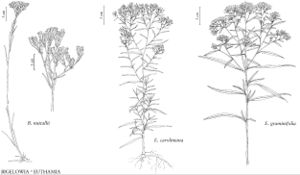Euthamia caroliniana
Mem. Torrey Bot. Club 5: 321. 1894.
Perennials, 25–100 cm. Stems (branched distal to midstems) glabrous or glabrate, not glaucous. Leaves deflexed to erect; blades 1–5-nerved, linear, 24–70 × 1–3 mm (to 6 mm wide in some Maine and Nova Scotia populations), lengths 7.7–42.2 times widths, abruptly reduced distally, lax- to firm-herbaceous, apices obtuse to long-acuminate, faces abundantly and prominently gland-dotted (34–86 dots per mm2), glabrous, glabrate, or scabro-hirtellous on midnerves. Heads pedunculate or glomerulate, usually in flat-topped or rounded arrays 10–40% of plant heights (often with multiple layers, proximal branches 0.5–1 times array heights). Involucres campanulate to turbinate, 3–4.7(–5.3) mm. Phyllaries usually green-tipped, outer ovate, inner oblong-linear, apices obtuse to acute. Ray florets 7–17(–25). Disc florets 3–22; corollas 3.3–4.8 mm. 2n = 18.
Phenology: Flowering Aug–Dec.
Habitat: Open, moist to wet, sandy soils, lake shores and dunes
Elevation: 0–100 m
Distribution

N.S., Ala., Conn., Del., Fla., Ga., Ill., Ind., La., Maine, Md., Mass., Mich., Miss., N.H., N.J., N.Y., N.C., Ohio, Pa., R.I., S.C., Va., W.Va.
Discussion
J. L. Reveal (1991c) determined that the types of Erigeron carolinianus and Solidago tenuifolia are conspecific.
Southern forms of Euthamia caroliniana tend to have fewer florets per head and narrower, more widely spreading (or even reflexed) leaves. E. L. Greene (1902) named these geographic variants (e.g., E. microcephala, E. microphylla). Overlap occurs in all characters; taxa cannot be confidently separated.
Euthamia galetorum has been considered an endemic restricted to lake shores in Nova Scotia (H. A. Gleason and A. Cronquist 1991; D. J. Sieren 1981). It has been collected from Cape Cod, Massachusetts, and southwestern Maine. Intermediates with E. caroliniana occur, and E. galetorum plants represent the endpoint of a morphologic cline. Most characters used to distinguish the two taxa are environmentally plastic and may not be genetically distinctive.
D. J. Sieren (1981) considered Euthamia caroliniana to be restricted to the Atlantic coastal plain. It occurs disjunctly in the southern Great Lakes region. Sieren considered the disjunct populations conspecific with E. gymnospermoides. H. A. Gleason and A. Cronquist (1991) called them E. remota Greene, related to E. gymnospermoides. The short disc corollas and involucres, narrow leaves, and production of axillary fascicles in some populations show clear relationship to E. caroliniana, from which disjunct plants cannot be reliably separated.
Selected References
None.
